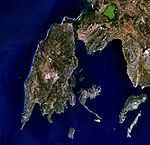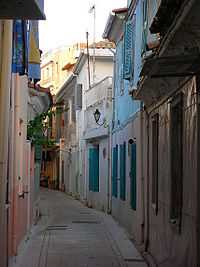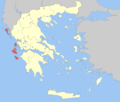Lefkada
| Lefkada Λευκάδα | |
|---|---|
 | |
| Location | |
 Lefkada | |
| Coordinates | 38°43′N 20°39′E / 38.717°N 20.650°ECoordinates: 38°43′N 20°39′E / 38.717°N 20.650°E |
Location within the region  | |
| Government | |
| Country: | Greece |
| Administrative region: | Ionian Islands |
| Regional unit: | Lefkada |
| Population statistics (as of 2011)[1] | |
| Municipality | |
| - Population: | 22,652 |
| - Area: | 335.8 km2 (130 sq mi) |
| - Density: | 67 /km2 (175 /sq mi) |
| Other | |
| Time zone: | EET/EEST (UTC+2/3) |
Lefkada, or Leucas or Leucadia or Lefkas or Leukas[2] (Greek: Λευκάδα, [lefˈkaða]; Ancient Greek and Katharevousa: Λευκάς), is a Greek island in the Ionian Sea on the west coast of Greece, connected to the mainland by a long causeway and floating bridge. The principal town of the island and seat of the municipality is Lefkada.[3] It is situated on the northern part of the island, approximately 20 minutes by automobile away from Aktion National Airport. The island is part of the regional unit of Lefkada.
History
The myth about Sappho's suicide at Cape Lefkada is related to other myths linking the island to the ancient Greek goddess of love, Aphrodite, and to Odysseus, the hero of Homer's Odyssey. The German archaeologist Wilhelm Dörpfeld, having performed excavations at various locations of Lefkada, was able to obtain funding to do work on the island by suggesting that Lefkada was Homer's Ithaca, and the palace of Odysseus was located west of Nydri on the south coast of Lefkada. There have been suggestions by local tourism officials that several passages in the Odyssey point to Lefkada as a possible model for Homeric Ithaca. The most notable of these passages pushed by the local tourism board describes Ithaca as an island reachable on foot, which was the case for Lefkada since it is not really an island, that it was connected to the mainland by a narrow causeway. According to Strabo, the coast of Acarnania was called Leucas in earlier times. The ancient sources call Leucas a Corinthian colony, perhaps with a Corcyraen participation.[4] During the Peloponnesian War Leucas had joined the Spartan Confederation.[5]
O Fotinós (or Der Helle in German), is a famous unfinished poem relating the so-called Voukentra revolution of 1357 in Lefkada against the Venetian (Italian) occupation by islander Aristotelis Valoritis.
The Ottomans called it "Ayamavra" (a rendering of the Greek Αγία Μαύρα (Saint Maura), the island's medieval name), and ruled it between 1479–1502, 1504–1684 and 1715-1716.[6][7]
Geography




Lefkada measures 35 kilometres (22 miles) from north to south, and 15 kilometres (9 miles) from east to west. Its area is 336 square kilometres (130 sq mi). Its highest point is the mountain Stavrota, 1,158 metres (3,799 feet) above sea level,[8] situated in the middle of the island. The east coast section of the island has small resorts of Lygia, Nikiana and Perigiali, all north of Nidri, the largest resort on the island. It is set in a sheltered location with views across to Skorpios—formerly owned by Aristotle Onassis, Meganissi and other small islands, as well as the Greek mainland. The main coastal road from Lefkada to Vasiliki runs through the village, although a bypass has now been completed which skirts the village to the west. There are regular car ferries to Kefalonia, Ithaca and Meganissi.
20 kilometres (12 miles) south of Nidri is the resort of Vasiliki, a windsurfing center. There are ferries to Kefalonia and Ithaca from Vasiliki. South of Vasiliki is Cape Lefkada, where the Greek female poet Sappho allegedly leapt to her death from the 30 m high cliffs.
The famous beach of Porto Katsiki is located on Lefkada's west coast. Lefkada was attached to mainland Greece (see above about Homer's Ithaca being Lefkada). The Corinthians dug a trench in the 7th century BC on its isthmus.[9]
Climate
The island has a typical Mediterranean climate: hot summers and cool winters, especially in the mountains.
Municipality
The present municipality Lefkada was formed at the 2011 local government reform by the merger of the following 7 former municipalities, that became municipal units:[3]
The municipality covers the island Lefkada and the smaller islands Kastos and Kalamos.
Transport
- Greek National Road 42
- Two other roads
- Aktio (Preveza) Airport
Notable people

(in chronological order)
- Spiridon Zambelios (1813-1881), historian
- Frederick Temple (1821-1902), Archbishop of Canterbury
- Aristotelis Valaoritis (1824-1879), poet and politician
- Lafcadio Hearn (1850–1904), Greco-Irish orientalist and writer, named after the island
- Petros Soumilas (1861–19??), Greek Army officer who reached the rank of Lieutenant General.
- Dimitrios Golemis (1874–1941), athlete
- Aggelos Sikelianos (1884–1951), poet and playwright
- Tzavalas Karousos or Karoussos (1904–1969), actor
- Panos Rontoyannis (1911–1996), philologist and historian
- Theodoros Stamos (1922–1997), Greek-American painter
- Apostolos Kaklamanis (1936), politician
- Agnes Baltsa (1944), opera singer
- George Contogeorgis (1947), political scientist
- Elli Tsarlaba-Stai (1954), journalist and talk show presenter
- Aristotle Onassis, Greek shipping tycoon
- Spyros Vrettos (1960), poet
- Maria Vamvakinou (1959), Member of the Australian House of Representatives
Gallery
-
Porto Katsiki beach
-

Madouri island
-

Kalamos village
-
Traditional dress
Notes
- ↑ Detailed census results 2011 (Greek)
- ↑ Potts, Jim (2010). The Ionian Islands and Epirus: A Cultural History. Oxford and New York: Oxford University Press. p. ix. ISBN 978-0-19-975416-8. Retrieved 16 June 2011.
- ↑ 3.0 3.1 Kallikratis law Greece Ministry of Interior (Greek)
- ↑ Colony and mother city in ancient Greece By A. J. Graham Page 132 ISBN 0-7190-0059-9
- ↑ The Peloponnesian War: Athens, Sparta and the struggle for Greece By Nigel Bagnall Page 17 ISBN 0-312-34215-2
- ↑ "Google Drive Görüntüleyici". Docs.google.com. Retrieved 2013-03-26.
- ↑ "Peloponnese". Citizendia. Retrieved 2013-03-26.
- ↑ Oreivatein.com
- ↑ Strabo 10.452
External links
| Wikimedia Commons has media related to Lefkada. |
- Lefkada Prefecture
- Lefkada The Official website of the Greek National Tourism Organisation
- Map of Homer's Ithaka (Lefkada), Same and Asteris according to Wilhelm Dörpfeld. Digital library of Heidelberg University.
- Photo of Dörpfeld's excavation site at Lefkada near Nydri, early in the 20th century. Digital library of Heidelberg University.
| ||||||||
| |||||||||||||||||||||||||||


